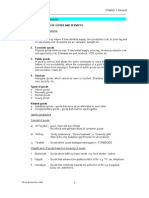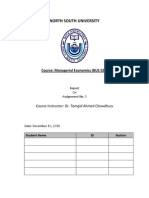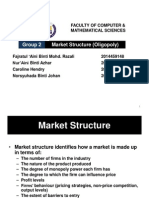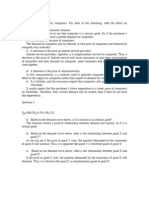Assignment#2
Uploaded by
Mavi Sang-olanAssignment#2
Uploaded by
Mavi Sang-olanASSIGNMENT #2 ECON201k
1. A linear demand curve has the equation Q = 50 100P. What is the choke price? 2. Explain why we might expect the price elasticity of demand for speedboats to be more negative than the price elasticity of demand for light bulbs. 3. The demand for beer in Japan is given by the following equation: Qd = 700 2P PN + 0.1I, where P is the price of beer, PN is the price of nuts, and I is average consumer income. a) What happens to the demand for beer when the price of nuts goes up? Are beer and nuts demand substitutes or demand complements? b) What happens to the demand for beer when average consumer income rises? c) Graph the demand curve for beer when PN = 100 and I = 10, 000. 4. Suppose the demand curve in a particular market is given by Q = 5 0.5P. a) Plot this curve in a graph. b) At what price will demand be unitary elastic? 5. Consider a linear demand curve, Q = 350 7P. a) Derive the inverse demand curve corresponding to this demand curve. b) What is the choke price? c) What is the price elasticity of demand at P = 50? 6. Suppose that the quantity of steel demanded in France is given by Qs = 100 2Ps + 0.5Y + 0.2PA, where Qs is the quantity of steel demanded per year, Ps is the market price of steel, Y is real GDP in France, and PA is the market price of aluminum. In 2011, Ps = 10, Y = 40, and PA = 100. How much steel will be demanded in 2011? What is the price elasticity of demand, given market conditions in 2011? 7. For the following pairs of goods, would you expect the cross-price elasticity of demand to be positive, negative, or zero? Briefly explain your answers. a) Tylenol and Advil b) DVD players and VCRs c) Hot dogs and buns 8. Many business travelers receive reimbursement from their companies when they travel by air, whereas vacation travelers typically pay for their trips out of their own pockets. How would this affect the comparison between the price elasticity of demand for air travel for business travelers versus vacation travelers?
You might also like
- Microeconomics Assignment - Kobra SoltaniNo ratings yetMicroeconomics Assignment - Kobra Soltani8 pages
- Microeconomics - Tutorial Practice Attempt 8&9No ratings yetMicroeconomics - Tutorial Practice Attempt 8&95 pages
- Week 3 Theory of The Consumer Questions1No ratings yetWeek 3 Theory of The Consumer Questions125 pages
- Microeconomics - Tutorial Practice Attempt 4No ratings yetMicroeconomics - Tutorial Practice Attempt 46 pages
- Microeconomics - Tutorial Practice Attempt 7No ratings yetMicroeconomics - Tutorial Practice Attempt 74 pages
- Consumers, Producers, and The Efficiency of Markets: Multiple ChoiceNo ratings yetConsumers, Producers, and The Efficiency of Markets: Multiple Choice36 pages
- Microeconomics - Tutorial Practice Attempt 5No ratings yetMicroeconomics - Tutorial Practice Attempt 56 pages
- Chapter 15 Consumer Surplus and Producer SurplusNo ratings yetChapter 15 Consumer Surplus and Producer Surplus19 pages
- ICFAI University Previous Years Question Paper 4No ratings yetICFAI University Previous Years Question Paper 424 pages



























































